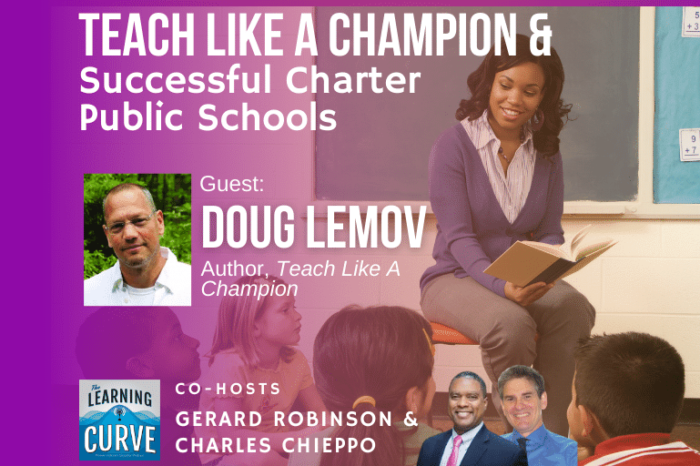Doug Lemov on Teach Like a Champion & Successful Charter Public Schools
/in Featured, Podcast, School Choice /by Editorial StaffThis week on “The Learning Curve,” Gerard Robinson and guest co-host Charles Chieppo talk with Doug Lemov, author of the international bestseller, Teach Like a Champion. Doug describes how he became interested in charter schools, dating back to the late 1990s in Massachusetts, and how the sector developed into a nationally recognized success story. He discusses his experience with the Uncommon Schools charter network, cited by Stanford’s CREDO for helping students make the greatest academic gains of any large charter network in the country. They delve into some key findings from Teach Like a Champion on academics and teacher qualifications. They also explore how parents and schools should address COVID-related learning loss, especially among the most vulnerable students. Finally, Doug shares highlights from his new book, Re-Connect: Building School Culture for Meaning, Purpose, and Belonging, on the impact of excessive screen time on students’ learning and mental health.
Stories of the Week: Is the future of gifted and talented education uncertain, and if so, will that remove incentives for some families to remain in public schools? In The Washington Post, Virginia education secretary Aimee Guidera outlines the Youngkin administration’s plans to ensure every family has access to a quality education.
Guest:
 Doug Lemov is the author of the international bestseller Teach Like a Champion–now in its 3.0 version–and, with his TLAC team colleagues, Reading Reconsidered, and Teaching in the Online Classroom. Next month he and three colleagues will publish Re-Connect: Building School Culture for Meaning, Purpose, and Belonging which outlines priorities and strategies for schools post-pandemic.
Doug Lemov is the author of the international bestseller Teach Like a Champion–now in its 3.0 version–and, with his TLAC team colleagues, Reading Reconsidered, and Teaching in the Online Classroom. Next month he and three colleagues will publish Re-Connect: Building School Culture for Meaning, Purpose, and Belonging which outlines priorities and strategies for schools post-pandemic.
The next episode will air on Weds., August 24th, with Alan Taylor, the Thomas Jefferson Memorial Foundation Professor of History at the University of Virginia, a two-time Pulitzer Prize winner, and the author of the book, Thomas Jefferson’s Education.
Tweet of the Week:
Recent enrollment data shows that in most states, public school enrollment has yet to recover to pre-pandemic levels.
Learn more in Bellwether's new tool: https://t.co/wGxy0fewtk pic.twitter.com/3BVstSzhIe
— Bellwether (@bellwetherorg) May 27, 2022
News Links:
The Unclear Future for Gifted-and-Talented Education
https://www.wsj.com/articles/the-unclear-future-for-gifted-and-talented-education-11660144014
Virginia’s education future is now on the right track
https://www.washingtonpost.com/opinions/2022/08/12/virginias-education-future-is-now-right-track/
Get new episodes of The Learning Curve in your inbox!
Read a Transcript of This Episode
Please excuse typos.
[00:00:00] GR: Hello listeners.
[00:00:23] GR: Welcome back to another wonderful show on the learning curve. This
[00:00:27] GR: week I am joined not by
[00:00:29] GR: Cara. Who’s taking a much deserved vacation. I’m actually here with a cohost named Charlie Chieppo. Some of you are familiar with his work and his relationship with the pioneer
[00:00:41] GR: Institute and because we’re getting new listeners every week, some of you may not.
[00:00:45] GR: Charlie. First of all, glad to be tag teaming with you today.
[00:00:49] Charlie: Oh, glad to be here. Glad to be with you jar. Thank you.
[00:00:53] GR: So Charlie, tell us a little bit
[00:00:54] GR: about who
[00:00:55] GR: you are, what you work on and what you do.
[00:00:57] Charlie: Well, I’m kind of a Jack of all traits, but I am [00:01:00] among other things, a senior fellow at pioneer Institute.
[00:01:03] And I, I work on several different issues, but certainly education has for she’s more than 20 years been one of the main topics that I work on, essentially what I do is more than anything else. I write about these topics for a variety of different publications and organizations and things like that.
[00:01:21] So have a long, long history fighting these battle.
[00:01:24] GR: So Charlie really good to join you again, and for
[00:01:27] Doug: our listeners who aren’t familiar with his work go to the pioneer Institute take a look
[00:01:31] GR: at the papers he’s produced uh, is really doing some good work. So Charlie has our guest co-host, I’m gonna turn it over to you.
[00:01:38] And you can tell us about your story the week.
[00:01:41] Charlie: sure. I was sort of captured by a wall street journal article by Ben Chapman that appeared last week about gifted and talented programs and kind of the tension that’s going on between their supporters and those who say they cause segregation and take resources away from needy your students.
[00:01:59] I have to [00:02:00] admit that it triggered one of my public education. Pet peeves, which is in my view, the trivialization of, excellence. And I, I would admit, I have undoubtedly been affected by what I’ve seen here in Massachusetts in recent years where, first, the, the. Best charter schools in the country kind of got taken down.
[00:02:19] Now I’m watching kind of the protectors of the status quo go after the vocational technical schools. And you know, interestingly to me, both of those options have attracted pretty diverse student. And I don’t know, I, I guess I’ve just become cynical enough to believe that it seems to me that, the one thing.
[00:02:37] Public schools, just can’t abide is, other public schools that achieve excellence, which I think is, just unfortunate. Now that’s not to say that diversity is not important. I mean, look, I grew up. In public schools in a middle class suburb of new Haven, Connecticut. And they could a few, we could have used a very strong dose of diversity.
[00:02:58] was in college [00:03:00] before I realized that every kid in America didn’t wake up to the, on Sunday mornings to the smell of sauce, simmering on the stove and the sound of the Italian radio station. Diversity absolutely needs to be a priority. Sometimes I’m starting to feel like it’s become the only priority.
[00:03:15] And you know, this has kind of been fed a little bit. I think also by my experience of I’ve started in the last couple of years, teaching college, both undergraduates and graduate students. I just don’t think that diversity in these gifted and talented programs are mutually exclusive. , in another life I spent almost eight years in college admissions and among the schools I visited were school called Benjamin Franklin high school in new Orleans and schools in Alabama and Louisiana.
[00:03:42] Where the very most talented students in the state went for their junior in sophomore years in high school and all three were very diverse schools. I also think that we need to look at the realities. Of the post pandemic economy you know, many employees, particularly those who pay the most [00:04:00] taxes can work from anywhere.
[00:04:01] And that’s why you see so many cities and states around the country, moving from economic development and strategies that are focused on recruiting companies, to ones that focus on recruiting people. We need gifted and talented programs and gifted and talented students to be economically competitive.
[00:04:19] the reality is that equity is cold comfort in the absence of a thriving economy. I also am interested in the issue of declining public school enrollment, which we’ll touch on briefly later, gifted and talented programs are an important way to attract middle class families too, or back to public schools.
[00:04:36] a public school system that’s disproportionately made up of those who can’t afford to go anywhere else. Really isn’t anyone’s idea of an equitable system. So just my reactions to this piece that I saw last week. Well, Charlie,
[00:04:51] GR: what you’re talking about is what I would call the unintentional war on merit.
[00:04:55] And here’s what I mean, I’m for. I’m for equality. [00:05:00] I’m for opportunity. I’m for what it’s going to take to close the opportunity gap and the achievement gap. And this isn’t a new, what call a new name game. We filed this in the sixties and seventies. In fact, with my parents. We’re in schools trying to move forward with integration.
[00:05:17] We had a different word, but there are ways of achieving what we want without I would say changing the script or changing the picture’s game, the ninth inning. I live in Virginia, I’m in Charlottesville, but the number one public high school in America is in Fairfax. It’s Thomas Jefferson high school.
[00:05:35] You had take, at least until recently you had to take a test to get in. It only took the student who had the best grade, the best test scores. Yes. A number of students don’t score well on tests, but there are a lot of students of. Who do. And so there’s been a big controversy with Thomas Jefferson and of course that led to some parents deciding to do something different with your child.
[00:05:58] But what you mentioned, I think [00:06:00] is going to come back to bite us later because we can actually address those issues in other arenas that may not have a test, but for example, we know Massachusetts, a great place for public charter schools. Guess what? Their students of color who may not have tested into a.
[00:06:18] Exam school, but who are getting a great education and actually passing the kind of exam we need at the collegiate level. If you are in New York, you know, the same thing with Bronx science, other schools, or if you are in California with Lowell school, that one of our. Recent springboard justices, Briar who stepped down what he attended.
[00:06:38] I’m for trying to find great opportunities, but I know that we’re not going to fix this system when you’re basically telling high achieving students and their parents who moved into neighborhoods or provided extra services for their children to get a education. because we’re trying to either color code classrooms or try to make equity, the sole goal at the expense of [00:07:00] achievement.
[00:07:00] And one of our colleagues have talked about this for a while, so that’s not 2 cents on the argument. Very well said. Thank you. So my article is from the Washington Post and it’s published by or written by Amy Guidera, who is the secretary of education here in the Commonwealth. As we know. Governor Youngkin was able to win and part because of a strong stance, he took for education, a strong stance that he took for opportunity.
[00:07:29] And one of the strongest things he did for his administration was picking Amy as the secretary of education. Many of us know her from her previous life. Where she worked as a founder and leader of the data quality campaign. Some of us also knew her in her life here in Virginia. Now, although she moved from Minnesota to take this job, there were a number of people who said, oh, I can’t believe he’s bringing an outsider.
[00:07:53] In to take care of Virginia’s families and children. Well, what most people did not know. And what Amy [00:08:00] identified in her article is that she actually lived in Virginia in part because her husband was a student at George Mason university. And because Virginia had great schools so much. So as she put her two daughters through Virginia schools, she then left Virginia and moved to the Midwest and now she’s returning home.
[00:08:18] So she isn’t speaking to someone who’s an outsider coming in. She’s speaking to someone who’s actually a consumer of Virginia public schools. And so she starts off her article by saying, oh, day one Governor Youngkin made sure that he said providing. Every student in Virginia, regardless of background, regardless of zip code and opportunity for quality education is what he wanted to do.
[00:08:40] And so he signed a couple of executive orders over events, maybe six or several weeks ago. I had a chance to travel to Richmond to participate in an event where Amy Guera talked about the governor’s. Move it into 90 days. And it was a blueprint for where they wanna take Virginia. She spoke the superintendent [00:09:00] of public construction spoke and governor young and himself spoke.
[00:09:03] And what she said then is pretty much where she articulated well in her article because they moved from that conversation to actually having a budget sign into law. And what she wanted people to realize is that when she used the word restore, there were some people who took it personally saying, wait a.
[00:09:20] Virginia’s got great schools. We don’t have to restore it. Its greatness. Some people said restore means maybe we are not as good as we say we are. Restore to some people meant, ah, this is a right wing push to somehow try to undermine public education. that’s exactly not why she mentioned the word restore.
[00:09:39] The reason she said she wanted to use restore was to acknowledge the fact that while Virginia has great schools, we have been falling behind, even though we still rank as one of the 10 best states in the country. In order to send your children to schools. And she didn’t say that without providing dating.
[00:09:55] So for example, she said that a culture of high expectations for [00:10:00] every one of our students should not tolerate the fact that get this. 42% of our second graders are not on track to read independently and that our reading scores on our standard of learning statewide tests have declined every year since 2017.
[00:10:16] Let’s just start with the first point 42% of our second graders are not on track. To read independently. And we know the importance of reading. We know the importance of what it means for the third grade. And we know what it means for the importance of understanding mathematical computations, particularly when they are words in terms of our standards of learning.
[00:10:37] That’s a challenge. She also identified that only 33% of our eighth graders are proficient in reading. And so to address the reading challenge and to acknowledge the fact that even with our own standards, there’s been a decline every year, since 2017 governing youngin signed a historic education budget.
[00:10:56] 3.2 billion largest in the history of Virginia, [00:11:00] it lays a strong foundation to restore excellence in education, by providing best in practice instruction into our classrooms. I’ll just identify a couple of points that she highlighted in the report. Just to prove that this isn’t just a conversation about rhetoric.
[00:11:15] It’s also a lot revenues before example, the investment includes a 10% salary. And a $1,000 bonus for every teacher to attract, grow and retain quality teachers. We know in Virginia’s been a split for number of years between the VA Virginia education association, some of its teachers and Republican administrations.
[00:11:37] The governor said he was going to provide a raise of teachers. Well, guess what? He kept his. Moving that forward. Since we’re talking about literacy, he also signed into law, the , Virginia literacy act, which will transformed the training and the tools used by teachers to work with students.
[00:11:54] He’s also allocated 1.2, 5 billion. We’re a combination of grants and school construction [00:12:00] loans to address what we need right now in the physical capacity of Virginia schools. We know that we have some challenges with students either in the classroom, outside of the classroom, but they’re also a number of families who say we need more school resource officers.
[00:12:15] So young can increase the 4.7 million school resource officer investment. By 22.5 million. And this is an important program that, increased fivefold. He’s also supporting 350 new school officers and he also provided money to our historically black colleges and universities. What she’s particularly proud of is a new 100 million investment.
[00:12:39] To create pioneering lab schools across the Commonwealth. And this will be created in partnership with public and private two and four year universities across the Commonwealth. So she wrote this article for the Washington post in part to say, Hey, a secretary of education. I want people in. DC, but also in [00:13:00] our region to understand what governor yin has invested in there was a bipartisan effort, but it’s also worth knowing that even in bipartisan efforts, there are times where partisan political take place.
[00:13:11] Amy is a supporter of a Virginia tax credit program started initially by Governor McDonald. When he was governor, I was secretary of education at the time to help move that along the railway. Well, there were actually some Democrats who wanted to cut the program by half and the governor fought for it.
[00:13:29] Amy fought for it as well as the families and schools who benefit from it. And we kept the $25 million cap for their tax credit program, which is geared toward lower income families, roughly 300% of poverty for student. And for families who have special needs students, it was actually 400%.
[00:13:48] So Amy has put that out there for us to read. I support the work that they’re doing and look forward to see what would happen with the new school year. What are your thoughts? You
[00:13:58] Charlie: know, Gerard, one thing that [00:14:00] you mentioned in there really is something that astonish. You know, the PR person and me in that, Virginia and Massachusetts are just two of the, higher performing states that have really seen these significant performance declines over recent years.
[00:14:17] And gotta tell you, there’s a part of me that is just amazed that with declines that are as material and as long lasting as these have been in a number of states, That these are not bigger issues. I mean, maybe, you hear more about it in Virginia, but you, you know, in Massachusetts, all we ever hear is how great things are while they just go down more and more every year.
[00:14:38] And it’s really concerning. And I’m, glad to see some political leaders at least, taking some action, trying to do something about it, cuz it’s a huge problem.
[00:14:47] GR: And when I think about Boston, Arguably the smartest city in America based upon the number of people, 25 and older, who have a bachelor’s degree, there’s a lot of brain power in [00:15:00] Boston and in the Boston suburbs.
[00:15:01] And yet when you look at the student achievement for poor white students who are in the system for poor black and Hispanic students in the system, many of them not reading on grade level, many of them dropping out. I mean, it’s just a challenge of how you can have that much just brain power and you have a brain drain in the system.
[00:15:21] I think some of that has to do with just the politics of what we choose to use our money for and trust me, Boston spending way more money per student than we are in Virginia. But even in Virginia, we’re one of the 10 smartest states in the country, but we often overlook region and class. For example, if you took Northern Virginia, And made it its own state that’s where approximately 70% of our bachelor degree holders.
[00:15:47] All of a sudden central Virginia and Southern Virginia look like really different states. And so when governing young was running for office, he made sure he went to central Virginia to Southwest Virginia, to south [00:16:00] side Virginia, because they’re often forgotten. And many of them are rural. Many of them are poor.
[00:16:05] Many of them are white, even if they’re not poor, they’re working class in middle class. And so this is as much an issue about region. Resources as it is about achievement. And I’m glad you mentioned Massachusetts, because this is almost a tale of two.
[00:16:22] Charlie: Yeah. And, you know, I tell you what you’re really hitting a, nerve with me because I actually, I went to law school in Nashville.
[00:16:28] And so I can’t tell you how much time I spent driving through, the Shenandoah and the blue Ridge and into the mountains of Western Virginia on the way to uh, Nashville. And it’s true. I mean, at least, Physically in terms of geography, the vast majority of that state is certainly very different from, you know, Alexandria and Fairfax county mm-hmm so a very good point.
[00:16:51] Mm-hmm.
[00:16:52] GR: Well, , you and I focused on education in schools, in our stories, and we’re now gonna have an opportunity to speak [00:17:00] to Doug Lemov, who is the author of the international bestseller teach like a champion, which is now in its 3.0 version. So we’ll be with him in a minute.
[00:17:41] Charlie: Well, I’d like to welcome Doug Lemov to The Learning Curve this week. Thanks Doug. For making time and joining. I’m happy to be here with you. Thanks for inviting me. Doug is the author of the international bestseller Teach Like A Champion, now in its 3.0 version. And with his teach like a champion team colleagues [00:18:00] also of “Reading Reconsidered and Teaching in the Online Classroom.”
[00:18:03] Next month, he and three colleagues will publish, Reconnect Building School Culture for Meaning Purpose and Belonging, which outlines, priorities and strategies for schools post pandemic. And God knows just from a couple of things we’ve touched on already here. The pandemic has certainly caused real problems in public education, in a real crisis.
[00:18:23] So I think we’re all looking forward to some strategies to try to deal with that and how we can address it. Well, Doug got a few questions for you. Let me start out with question. That’s kind of close to my heart. Having been there at the time, in the late nineties and the early two thousands you began your career working in charter school sector here in Massachusetts.
[00:18:43] Certainly a time that I remember and would love to hear you talk about that experience, what the landscape was like, as well as some of the school leaders and policy leaders who helped shape, what was a real success story?
[00:18:56] Doug: Yeah, well, you know, it really was a success story and so many people contributed to [00:19:00] it.
[00:19:00] So, happy to maybe played a tiny role in it. It was you know, it was a time of real intellectual format I think we got a lot, right. I think we got some things wrong, right. There’s a lot to figure out in running great schools for kids and in places where, where they didn’t always get ’em.
[00:19:15] But I think that one of the things that’s, you know, as I think back on that time was the healthy sense of cooperation, you know, there was maybe a core group of charter schools that I worked with regularly. And our goal was to you. We all wanted to work together and share ideas.
[00:19:30] And we also all kind of wanted to be the best. And there was a really healthy sense of both supporting and challenging each other. And then there was also, you know, I think it was very early on, but there was the beginning of what you might describe as infrastructure. And in this case, it was Linda Brown who was supported by the pioneer Institute who.
[00:19:50] Helped all of us to solve many of the, you know, early stage problems that we, that, you know, that came up inevitably in trying to run great schools. So exciting times, deep learning curve[00:20:00] and lots of just, really talented people involved in trying to rethink what we were doing back then.
[00:20:06] Charlie: Well, there’s no one who was around at that time and who has ever dealt with her, who would ever for a moment forget Linda Brown. She is one of the really unforgettable characters that I’ve come across in my career and someone who has sort of really enriched my life and my thinking on these issues.
[00:20:22] So I can certainly, second your feelings on that. So moving up forward in time a little bit until recently you were at uncommon schools and according to a study by credo, the Stanford university organization, that many of us who, who. Or in the charter school world certainly pay a lot of attention to their studies, but uncommon school students made the greatest academic achievements of any large charter network in the country.
[00:20:47] So, be interested in having you share with us your experience there and why you think these charters are so successful. and what it looks like right now for the larger charter school environment, which is certain. [00:21:00] Changed over time. Yeah, for sure.
[00:21:03] Doug: it’s funny Brett Peiser, who’s the CEO of Uncommon now has a great phrase.
[00:21:07] You know, there is no 100 percent solution. There are only a hundred, 1% solutions. if I think about what makes Uncommon School successful, I think it’s, you know, The fascination with love, for appreciation for the apparently mundane, you know, the tiny decisions that we make in the course of every day and how to make each one a little bit better, have another colleague who says, the biggest barrier to student achievement is adults not focused enough on student achievement.
[00:21:32] And you know, the, the game is always changing, right? You solve one problem and that creates another, you solve one problem and it creates another challenge or another opportunity. And so. I think one of the things that people misunderstand most about the top schools that I know, which I would include, you know, many uncommon schools and many non uncommon schools, it’s just their sort of sense of restless.
[00:21:51] Self-reflection constantly gathering both, quantitative and anecdotal data on how things are going and always thinking about like what, you know, [00:22:00] what’s next for us on the learning curve. So I think there’s a great combination of, , desire for excellence and real humility of like, We’ve done some good work here, but there’s a long way to go.
[00:22:11] And we really can’t really can’t ever stop trying to refine every detail, I think even the details that many people might find mundane or to, you know, too mundane to be really interesting are often the drivers of excellence. One of my favorite books on organizational change is chip and Dan heat’s book switch, and they say, you know, they just describe.
[00:22:32] Case studies in the animals of organizational change and improvement. And one of the fascinating observations they have is that the, we always assume that the size of the solution has to map to the size of a problem, but that’s actually not true. And oftentimes, you know, our really careful implementation of a small detail can cascade through an entire organization.
[00:22:53] So, there’s a real sense sort of swatch makers feel in a lot of the top schools that. [00:23:00] It’s really dynamic and exciting.
[00:23:01] Charlie: You know, what strikes me in that answer, Doug is, you think just sort of generically of a, pretty large network of schools and mm-hmm, you think of a lot of, top down policies, so kind of things, but what I hear you talking about is these sort of very granular, almost very individual, of adjustments you make along the.
[00:23:23] , it doesn’t seem to be that it, you know, a lot of the answers are not something that you, find in the company handbook.
[00:23:29] Doug: Yeah. I think that’s right. You know, I think it’s really hard to run a centralized bureaucracy that achieves excellence.
[00:23:36] the world of education is full of talented driven people who wanna do the best for young people. And if it weren’t true if, if it weren’t true that centralized command and control bureaucracies didn’t disrupt the potential of those people to do great work.
[00:23:51] There would be outlier models in school districts and especially in urban school districts around the country. And I think it’s, challenging to [00:24:00] find a consistent outlier school district that has achieved high level results, like, students deserve. And so I think one of the things we’ve had to learn in the, charter school sector where we’re, we’re given the benefit of more flexibility is not to create the, centralized command and control of bureaucracy under the banner of reform.
[00:24:19] And as you get bigger and as you get more complex as an organization, you know, everything that you don’t standardize becomes. Challenging to manage. And so there’s a temptation to well, I think there’s a difference between standardization and systemization, but there’s a, temptation to over standardize.
[00:24:34] And I think that’s just one of the challenges of growth that I think the best organizations are constantly attentive to that. They want to. Maintaining accountability and autonomy at the same levels of the organization, so that, you know, people at the front lines and near the front lines are, are making key decisions and passing information to the other places in the organization where decisions get made.
[00:24:55] So that it’s as much top up as top down. I just think of that as that’s central. [00:25:00] We, we should never lose. We’d never lose sight of
[00:25:03] GR: that.
[00:25:04] Charlie: Yeah, no, that’s a , very good point. in addition to uh, our sort of longstanding involve. With charter schools pioneer, one of the other things that we’ve been very involved with is that we’ve always been very strong advocates for the liberal arts even sort of trying to make that case to my own kids with Nick’s success.
[00:25:22] But,
[00:25:23] Doug: and it makes you makes me feel any better. I’ve had mixed success
[00:25:25] Charlie: also with my plan. Oh yeah. Well, good. All right. I’m glad it’s not just me. So I was wondering if you could, talk about some of the main. From teach like a champion. And also curious, if the role of the liberal arts has been a part of any of those lessons that you’ve learned along the way.
[00:25:41] Yeah. Well, I, I
[00:25:42] Doug: answer this as much a parent, as much as an educator, which is I continue to believe that reading and writing at the core. the core of learning, right? The processes that we developed,
[00:25:54] As part of our ability to build ideas as societies, right. Reading and writing have always [00:26:00] been central to that.
[00:26:00] I believe that literacy in particular and the liberal arts are central to our. reading is a subject, English is a subject, but they’re also thinking tools that are profound in, in every subject area. And so, you know, if people sometimes ask me what my favorite techniques are and teach like a champion and first I try not to answer, but then when forced to answer, you know, I’m really, I really gravitate to the writing chapters and one of the reading techniques, which I’ll come to and maybe in a second, because I think, learning to write is learning to.
[00:26:31] one of the things that happens so often, I think in schools is writing very quickly, can become a tool for explaining and justifying your opinions only. And certainly that’s something important and valid that we do with writing. But writing is also a tool for thinking in which, you know, there should be.
[00:26:48] I think there should be lots of examples of cases
[00:26:50] GR: where student.
[00:26:51] Doug: are asked to write before they know what their opinion is, and they’re actually using writing as a tool to discover what their opinion is, because I think that’s one of it [00:27:00] forces you to think with clarity and with precision and to reflect on what your thoughts are.
[00:27:06] And if you’re not clear on what you think will show up in your writing. I really, really believe, especially now that. technology is changing our lives very quickly. I write a lot and reconnect
[00:27:16] GR: about the effect of the, cell
[00:27:17] Doug: phone and social media, but even in the classroom, you know, more and more screens.
[00:27:21] I really believe that low tech and high text, lots of time in books and lots of time writing reflectively , are just profoundly important in the classrooms. And if I look, you know, I, I think. Other synergies, other commonalities among, you know, the sort of top performing teachers that I tend to find.
[00:27:39] But one of them is definitely a really profound interest in just, you know, regular reading and regular writing, no matter what the subject is. Right. Great. You know, you look in, you walk into a great science teacher’s classroom and they’re likely to say, take two minutes to jot down some initial thoughts about what the relationship is between, oxygen and growth rate in the data set.
[00:27:58] Right. And as soon as I do.[00:28:00] And I build a culture of, of written reflection. First of all, every, instead of taking a hand and having one student answer the question, 30 students in the classroom are answering the question. And when I have to write, have to lock down my idea of precise, syntax and precise vocabulary.
[00:28:13] And so the rigor of like thinking is instantly higher. And so, you know, I think just to go back to this idea of the size of the solution does not always the size of the problem or the place to build, to build a more rigorous classroom, just to have. Write more in small reflective moments throughout the course of the lesson.
[00:28:31] Charlie: Well, you know, you are speaking my language because I now teach your writing course and oh, great. Yeah. And what I, say to my students, I, the time is, is a public policy writing class and what I have them write some opinion stuff. And what I say to them all the time is, if your writing is all over the place and, you know, I don’t really know what you think about the issue I’m gonna know.
[00:28:53] I can tell immediately that it’s not necessarily about your writing. It’s about the fact that, it’s not that you’re not writing clearly. It’s cuz you’re not [00:29:00] writing clearly because you haven’t thought clearly cuz you don’t know what you think and, and writing you’re right. Is such a tool to force yourself.
[00:29:07] It’s like a discipline to make yourself really think about. What it is that you wanna say, if you’re gonna do it well, and to get it down in a way that is clear. And in many cases, depending on the kind of writing persuasive, so.
[00:29:21] Doug: and I think that that has cascading effects throughout a class, you know?
[00:29:24] So if in, in the typical classroom, if there’s writing that happens and too often there isn’t, it happens at the end of class. Right? So kids, students might write at the end, you know, like summarize what we talked about today. Like, and honestly, that’s, I’m pretty happy to see that cuz not every class does that.
[00:29:38] But if you write earlier in the class in small verses, for example, if you write before you have a class discuss. So we say I wanna discuss the figurative language in the first stands of the poem. But first I want to give you 90 seconds to jot down your initial thoughts.
[00:29:52] What might be important in the figurative language in the poem go right. Then when I start my discussion, everyone has [00:30:00] already thought through the answer. And so what gets said verbally in class is gonna be version 2.0, at least for kids and the kids who are. Not quite comfortable. Speaking extemporaneously have notes in front of them.
[00:30:15] And so they’re more likely to raise their hands. And in fact, everyone is more likely to raise their hands cause they actually have some thoughts. And so maybe it democratizes participation a little bit. And actually I can walk around and look over students’ shoulder and say, oh, Charlie, use the word exonerate.
[00:30:27] That’s so interesting. Let’s talk about that word. Or, you know, Charlie start us off there. And so I can actually draw kids into the convers. by pulling on their ideas just by looking over their shoulders while they write. And then, you know, I, I think that listening is one of the most overlooked aspects of class, you know, so often we evaluate the quality of, we evaluate discussion based on how much talking happens.
[00:30:51] But if all we have is talking and no one is listening, we have the American political process in our classrooms. I’m not sure that’s, I’m not sure that’s a good thing. when you write your thoughts, [00:31:00] You free your working memory to listen better to other people. If, while you’re talking, I’m trying to, my internal narrative is what I wanted to say was what I wanted to say was what I wanted to say was then you’re done talking.
[00:31:12] I raised my hand and I say, what I wanted to say was I’m one, not building off of your idea, not listening to you because I, I can’t keep your idea and my idea and working memory at the same. And then when I speak, I’m sending the message to what you said. Didn’t matter to me at all. It was irrelevant. And I’m just gonna say what I was gonna say before you, you spoke anyway and that’s a disincentive to you and my classmates to speak.
[00:31:32] So I think something simple, like writing can, just has profound effects on everything that happens in the classroom, especially if it happens early in the, in the learning process.
[00:31:41] Charlie: Right. Well, thank you. I’m gonna turn it over. I think that Gerard has some questions.
[00:31:46] Doug: great. I’m sorry to go through nerd there in writing.
[00:31:48] I just that’s. All right.
[00:31:51] GR: Now that’s why we call this the learning curve. Always opportunities for us to learn deep dive and otherwise. Well, for starters, I’m glad you mentioned Linda [00:32:00] Brown in a previous life had a chance to speak. To a cohort of her uh, building that’s in school fellows and even had an opportunity to create a charter school in Atlanta with the BS fellow ed Chan.
[00:32:10] So she is one of the founding mothers of this movement. So, wanna give her a shout out as well?
[00:32:17] Doug: She’s a, she, the hero. I just wanna, I just wanna double click on that. She’s a hero, so thank you for, thank you for calling her out.
[00:32:24] GR: Oh, no problem. Thank you for giving the opportunity to do so. So let’s talk COVID Teachers in particular became the forefront of the conversation.
[00:32:33] Good, bad, ugly, hopeful, and otherwise, and you’ve seen this firsthand, but what most people are starting to really get their arms around is just the impact it had regarding learning loss, particularly for our most vulnerable students. Mm-hmm , you know, what do you discuss? let’s say in front of parents, teachers and schools, what should they be doing based on what you know, to address this learning loss?
[00:32:56] Doug: Well, the first thing is both simple and [00:33:00] complex. It’s a simple decision that’s complex to execute on. But I think when we talk about the pandemic, we have to talk about the pandemic within the epidemic. And the pandemic is a year and a half that kids spent cut off and isolated from all the things that, connected them to communities in their lives.
[00:33:16] And that had an immense social cost for them. And the fact that they missed out on the C. And if nothing else, the last 18 months, you know, go 18 months of the pandemic should demonstrate for that classrooms matter because the academic cost was massive, but that pandemic happened within the larger epidemic.
[00:33:33] And that epidemic is social media and C phones. And I start the book talking about gene twenties, research into the spiraling rates of teen isolation, depression and loneliness. That started in , 2011, that historic rates that coincide with the sort of universal adaptation among teenagers of the cell phone.
[00:33:54] And so this is, has two effects on young people. a cell phone, social media is an [00:34:00] attention, is the attention eroding machine. It distracts your ability to maintain, focus and concentration on any intellectual or academic task. And it’s also as twins research showed, it causes isolation and disconnection at a time.
[00:34:14] Kids most need to be connected. PS, what did they do when they were stuck in their rooms during the pandemic, they double down on their , dosage of social media. And so the average, you know, high school students spend something like
[00:34:25] GR: eight hours today on social media,
[00:34:27] Doug: For institutions. Who’s service to societies based on their ability to help students focus their attention on learning tasks.
[00:34:37] And they seek to connect students to a child to one another and make them feel, a part of an institution of part of an, you know, a shared endeavor. The first step I think, is to restrict cell phones to schools. It has to be done. There are people who tell you it can’t be. But the state of Victoria and Australia and, you know, networks of schools in England and networks of schools in France have done it.
[00:34:56] So there’s no reason that we can’t do it as well. So I think that’s [00:35:00] step number one. And then, I think there are a couple of key things to be thinking about. In addition, I think one of them is just, the classroom. It can’t be a choice between building a sense of belonging for students and maximizing academic.
[00:35:13] But fortunately, I think those things work in synergy. And so the, third chapter of the book is really how do we build classrooms, where we maximize the environment around student learning. And at the same time, make students feel like they are important. Like they belong and like, their time the classroom is meaningful.
[00:35:28] And I think that actually some of the core things there come down to things that I was sort of talking about when I was talking about writing. If I asked you to make a comment in class and you and I, you know, I say, what did you think about Jon’s behavior at the end of the chapter? how is he changing in important ways?
[00:35:44] And you make a comment and the next person who comments after you in class, doesn’t acknowledge what you said and implies that, , your comment was irrelevant then you’re not likely to talk again. And This happens to students all the time. They operate in an [00:36:00] environment where they look around, as we ask them to, to talk about the novel and the body language of their classmates says, I don’t give a damn what you’re saying right now.
[00:36:07] no one seems to value the words that they say. And so I, you know, when you look at great teachers, I think they do things to make sure that, that students talk to each other and not pass each other. And they listen carefully and they develop ideas in collaboration. And so I think those.
[00:36:22] Both make students feel connection and belonging in the classroom, which is important for them. Psychosocially right now. But it’s also, those are important learning behaviors. And the reason I perseverate on that a little bit is just because there are a lot of things that we can do on the margins in school.
[00:36:36] And we can, you know, we can add socio-emotional programming possibly, and we can enrich extracurriculars, but 80% of the time that kids spend in school is gonna be spending classrooms and that the classrooms don’t do their core work better. we’re not gonna make the fundamental changes
[00:36:51] GR: that we need to.
[00:36:52] Some of the items that you just shared with us appeared recently in an education next piece which draws from your new book. [00:37:00] WEConnect building school culture for meaning, purpose and belonging. What’s the aha moment for you that made you say, you know what. I’m going to tell people, take away your cell phones.
[00:37:10] Not only for some parents, it’s a congratulations, but for the teens and the young people, you’re now like the evil guy, what was the ah-ha that made you say, Hey, we’ve gotta do this. And then, you know, provide a platform to show us how to do it. Yeah,
[00:37:26] Doug: it’s interesting. I don’t know that I could lock it down in one specific moment.
[00:37:29] I think it was a in just anion. data that I’ve been reading over and over it, it started with Maryanne Wolf’s book reader come home, I was an English major. I love reading. Reading’s a profound part of my life. And as a parent, it’s really, you know, if there’s one thing I could give my kids, it would be a love for, and a habit of reading.
[00:37:50] And until they got their cell phones, my kids were all voracious readers. And when they got their cell phones, it became this incredible struggle to get them to read regularly. And even [00:38:00] when they did read, I’m just, I have this image in my head and my son lying on the couch with a book in his hand, when, you know, I sort of, maybe I pushed him to, finally read and his, book is on his hand, but his cell phone is on his chest.
[00:38:11] And as he’s reading, he’s getting these constant push messages. And so his version of I know why the cage bird sings is interspersed with these constant constant interruptions about what, you know, what Kevin is up to and what Stewart is up to. And, you know, dude, come hang out and so that’s a fundamentally different experience instead of, you know, when we read growing up, we lost ourselves in deep reflection in reading a book for an hour at a time.
[00:38:37] And young people today’s experience of text is State of constant hypertension forever interrupted by other thoughts. And so maybe as a parent, I read this book and I just started to think from a very personal perspective, this device that I wish I could take outta my kids’ hands, but I can’t because it’s their form of connection to all their peers is [00:39:00] degrading their, not just their likelihood of reading, but their ability to.
[00:39:04] You know, if you build your capacity to concentrate by practicing concentrating. And if you spend your time in a constant state of half attention, your brain adapts to that and expects to have constant distraction. And so, you know, maybe that, that was the starting point, started to read more cognitive science and just realize how incredibly destructive these Divi, you know, they, they clearly have immense benefits to society as well, but.
[00:39:30] In schools, they are Des disrupting and really there’s a collective action problem there, which is as a parent, I load cell phones. Why are you asking? And I just take my kid’s cell phone away. Well, because none of their friends are like, Hey, we’ll call you on your landline. We’re all going to hang out on the soccer team.
[00:39:46] Doesn’t say, Hey, let me know. We we’ll let everyone know by tax one practices, except you will, you know, we’ll call you on your landline. The only way to limit students exposure. To the technology is if everyone does it [00:40:00] as a group and schools are one of the last places where that can potentially happen in our society.
[00:40:05] And I’m not saying that that society should take away their cell phones, but they do young people deserve to grow up in an environment where there are stretches of time where their minds work in a more concerted focused attentive way. I think one of the interesting things is, will students resist this?
[00:40:22] Will some parents resist the idea. Of course they will. But the interesting thing is if you talk to schools that have done it very soon after the change is made, the kids are actually much happier and the parents are too, people are surprised by how much it enriches their lives to have time to connect
[00:40:36] GR: face to face with people and be in the.
[00:40:39] Well, thanks so much for sharing your personal story within your own household, and then giving it to the rest of us to think about for our family through lens of policy, practice, and purpose. I’ve got a now a high school daughter and, you know, she’s a. Cell phone lover as well. And hearing you talk, I’m hearing some of that in my [00:41:00] own household.
[00:41:00] So I’ve got a few points I’m gonna share with her when she returns from vacation. again, Doug, you know, and if, and of course, if she gets mad at me, I’ll give her your cell number. And so, yeah, well she won, she won’t be the first in line. Exactly. Thank you. Look heavy, but no Charlie and I really enjoy you chopped it up with us on the, subject at hand and look forward to either seeing you in person in a, not too distant future, but of course, following your work and for listeners his book will come out soon.
[00:41:31] You can definitely check out his article and education next, and until we meet again, keep up with good work.
[00:41:37] Doug: Thanks very much. Thanks for having me on, take care.[00:42:00]
[00:42:38] Charlie: This week’s tweet of the week is one that I saw from bellwether education which is said that recent enrollment data shows that in most states public school enrollment has yet to recover to pre pandemic levels. And they have a. tool that they direct you to, to sort of check that out in different places around the country.
[00:42:56] And I’ll tell you, the reason this really caught my attention was because [00:43:00] we’ve recently done some work here at pioneer about the fact that Boston has seen a slight increase in the number of public school age children, yet Boston public school enroll. Continues to decline.
[00:43:12] So I’m very interested to see that that’s happening at other places around the country. And what I would really love to know is, are the demographic characteristics of the people who are leading the public schools and just where are they going? I think it’s important issue for us to keep an eye on.
[00:43:27] GR: That’s a great tweet of the week. And guests next week will be joined by Alan Taylor, who is the Thomas Jefferson Memorial foundation professor of history at the university of Virginia and a two time pulitzer prize winner and the author of the book, Thomas Jefferson’s education. Look forward to that conversation with someone who is a scholar in the city that Thomas Jefferson in part helped to build through his academical village.
[00:43:55] Well, Charlie, thanks so much for joining me this week. [00:44:00] I look forward to having you on board when Cara is out again, but more importantly, now that we can travel and I would find myself up in your neck of the woods at at some point, look forward to catching up in person. Well,
[00:44:12] Charlie: that would be great.
[00:44:12] Pleasure to be on with you. And thanks for taking such good care of me. Take care.
Recent Episodes

Best-Selling, Netflix Author Loung Ung On Surviving Pol Pot’s Killing Fields

American Federation for Children’s Tommy Schultz on School Choice & Edu Federalism
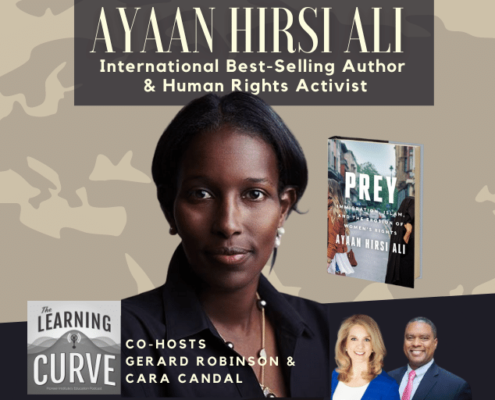
Ayaan Hirsi Ali, International Best-Selling Author & Human Rights Activist
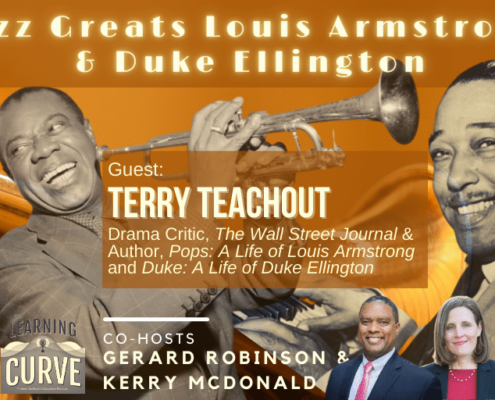
WSJ Drama Editor Terry Teachout on Jazz Greats Louis Armstrong & Duke Ellington
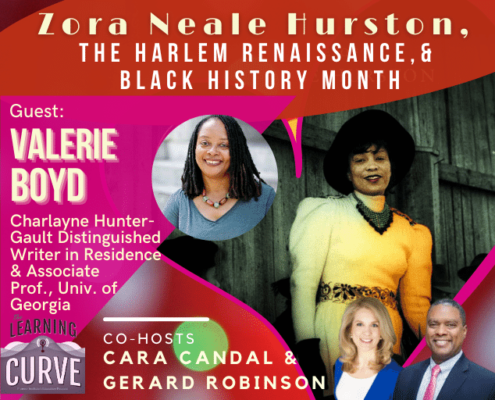
UGA Prof. Valerie Boyd on Zora Neale Hurston, the Harlem Renaissance, & Black History Month
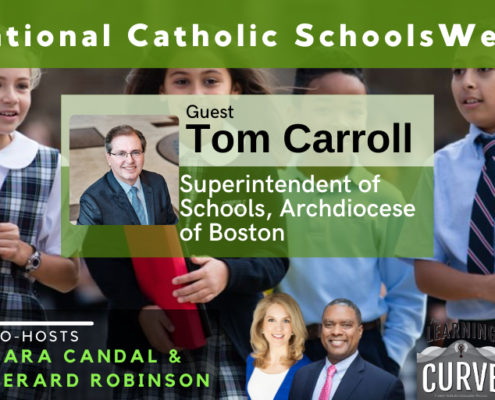
Boston Catholic Schools Supt. Tom Carroll on National Catholic Schools Week
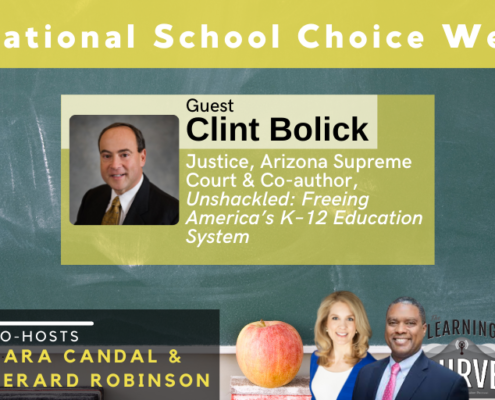
AZ Supreme Court Justice Clint Bolick on National School Choice Week

Pulitzer Winner Taylor Branch on MLK, Civil Rights History, & Race in America
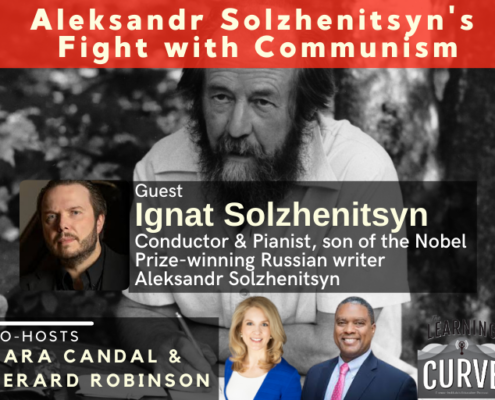
Ignat Solzhenitsyn on His Father’s Nobel Prize-Winning Fight with Communism
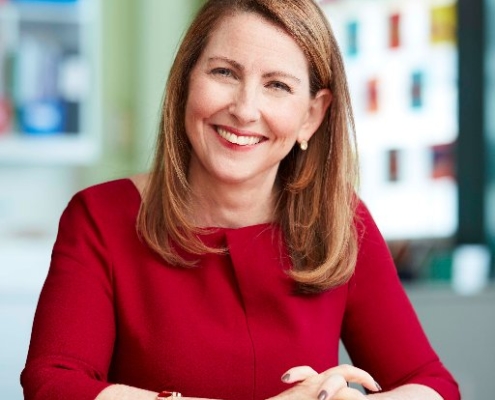
Eva Moskowitz of Success Academy on Charter Schools, Achievement Gaps, & COVID-19 Learning Loss
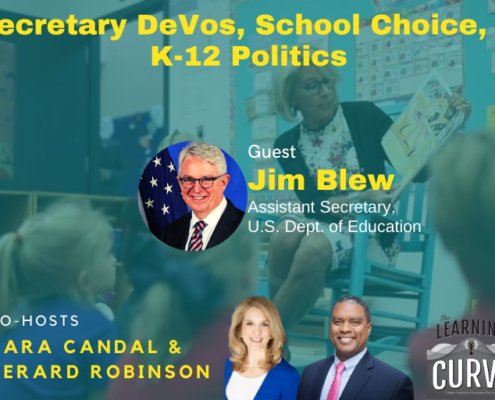
USED Asst. Sec. Jim Blew Talks Sec. DeVos, School Choice, & K-12 Politics

Oxford & UCLA Pulitzer Winner Prof. Daniel Walker Howe on Horace Mann, Common Schools, & Educating for Democracy

